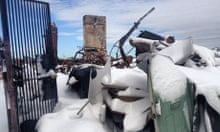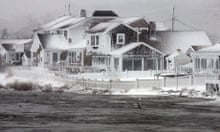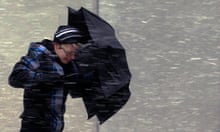The north-east of the United States was smothered by snow on Saturday with falls of up to three feet (more than half a metre) causing blackouts and the closure of a nuclear power station.
Hundreds of thousands of people lost power – more than 200,000 in Massachusetts, more than 100,000 in Rhode Island, and 30,000 in Connecticut, according to power companies.
More than 2ft (60cm) of snow fell on central Connecticut and parts of Rhode Island, New Hampshire and south-east Massachusetts, with Boston due to get up to 3ft (90cm). New York City was due to get about 1ft (30cm) with more expected elsewhere in the state, while heavy snowfall was also predicted in Connecticut and Maine.
Winds reached 35 to 40 miles per hour by Friday afternoon and forecasters expected gusts up to 60mph.
The storm prompted the governors of Massachusetts, Rhode Island, Connecticut, New York and Maine to declare states of emergency in the face of the fearsome snowstorm. The Massachusetts governor, Deval Patrick, took the rare step of announcing a ban on most car travel starting on Friday afternoon, while the Connecticut governor, Dannel Malloy, closed the state's main roads to all but emergency vehicles.
Blizzard warnings were in place from New Jersey to southern Maine, including New York City and Boston. Commuters were repeatedly warned not to travel on Friday evening or Saturday, with the National Weather Service warning that visibility could be "near zero in white-out conditions".
The National Weather Service said Boston could receive three feet (90cm) of snow, which would rank as the city's largest ever snowfall. The previous high of 27.6 inches was recorded in 2003. Cities from Hartford, Connecticut, to Portland, Maine, were expected to see at least a foot of snow, the NWS said, while New York City was predicted to see 12.1 inches.
By Friday night some commuter trains between New York City and Westchester County, Long Island and Connecticut had already been suspended. Amtrak suspended rail services between New York, Boston and points north on Friday afternoon.
About 3,500 flights were cancelled on Friday and hundreds more on Saturday. Most airlines had cancelled flights in and out of New York City and Boston as well as smaller airports in the region before the storm. The flight tracking website Flight Aware said over 3,100 flights had been cancelled on Friday and a further 1,000 on Saturday. Passengers were advised to check with their airline before travelling to the airport.
The Pilgrim nuclear power plant in Plymouth, Massachusetts, lost power and automatically shut down on Friday. An official at the Nuclear Regulatory Commission said: "There was no impact on plant workers or the public."
In many cases, authorities ordered non-essential government workers to stay at home, urged private employers to do the same, told people to prepare for power cuts and encouraged them to check on elderly or disabled neighbours.
"People need to take this storm seriously," said Malloy. "Please stay home once the weather gets bad except in the case of real emergency."
The Federal Emergency Management Agency said it was monitoring the storm and would hold "regular operational briefings" with state agencies in affected areas on Friday and Saturday.
The storm wasn't bad news for everyone. The New York mayor, Michael Bloomberg, suggested that people relax at home by cooking or watching a film. Bloomberg said he planned to catch up on his sleep.
As she stocked up at a Brooklyn grocery store, 28-year-old Jackie Chevallier said that after two years without much snow, she was looking forward to waking up to a sea of white.
"I'd like to go sledding," she said.
The storm also posed a risk of flooding at high tide to areas still recovering from last October's hurricane.
"Many of the same communities that were inundated by Hurricane Sandy's tidal surge just about 100 days ago are likely to see some moderate coastal flooding this evening," said Bloomberg.






